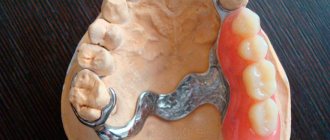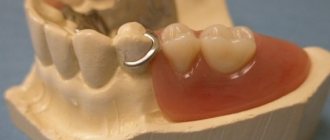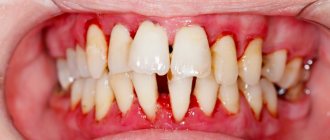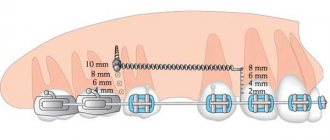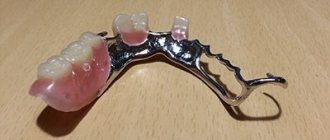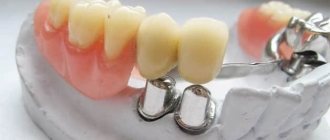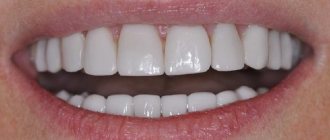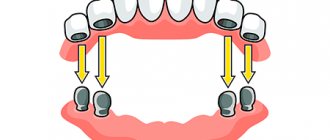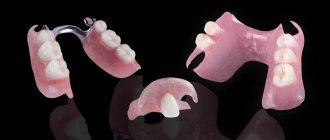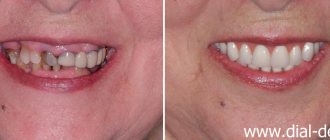The patient, 54 years old, accidentally entered the clinic, confusing it with another clinic, and decided to stay and get specialist advice.
Duration of treatment
5 months
| Surgical stage: | |
| MIS implants | 25,000 rub. |
| Heal former | 4,000 rub. |
| Orthopedic stage: | |
| Beam | 25,000 rub. |
| Bar prosthesis on implants | 80,000 rub. |
Prosthetic options when choosing dental implantation: an overview of all possible solutions
Article navigation
- Problems when choosing classic dentures
- - problems with dental bridges
- - problems with removable dentures
- Implant and native tooth as supports
- Indications and contraindications
- Types of dentures
- - removable
- Fixed dentures on implants
- — single crowns on implants
- - bridge structures
- - fixed structures with artificial gum contour
- Temporary prosthetics on implants
- - with a classic two-stage approach
- - with one-stage implantation
- Types of dental crowns
- Stages and deadlines
- - with a classic two-stage protocol
- - with one-step methods
- Disadvantages of prosthetics
- - need for re-prosthetics
- - high cost of treatment
- - need for surgery
- What is the price
- Rules of care
Question for a specialist
Dental implantation is a complex process that consists of several directions. And the implantation of implants is a surgical stage that lays the foundation for future restoration of the dentition. After installing them in the bone, an aesthetically important stage begins - prosthetics - the selection and installation of the supragingival part of the system (or crowns), which will replace the lost natural teeth. Today we invite you to talk about all possible types of prosthetics on implants, their advantages and disadvantages, features and those nuances that you should definitely pay attention to when choosing one of the many treatment options.
Contraindications
You will have to refuse prosthetics on implants if there are contraindications to the implantation of titanium rods:
- violation of blood clotting properties;
- uncompensated diabetes mellitus;
- weakening of the tone of the masticatory muscles;
- tuberculosis and other serious respiratory diseases;
- inflammatory processes, benign and malignant tumors in the oral cavity;
- presence of untreated teeth;
- connective tissue pathologies;
- exacerbation of chronic diseases;
- nervous disorders;
- AIDS, HIV;
- pregnancy and breastfeeding;
- undergoing radiation therapy;
- inability to use anesthesia.
What problems arise when choosing classic dentures?
Dental restoration in one way or another depends on the patient’s clinical situation, his wishes and capabilities. But there is no doubt that the timely restoration of lost teeth is a necessity. This can be done with the help of prosthetics. From the point of view of the beauty of a smile and the quality of chewing food, transfer of chewing load and prevention of bone tissue atrophy, dental implantation is the best option. Why are other popular methods of classical prosthetics less effective? Let’s find out where they are inferior to implantation.
Interesting fact! When our teeth are in their intended place and function normally, they transfer the entire load to the jawbone, which receives nutrients and maintains its volume, which greatly affects the condition of the maxillofacial system and the entire body as a whole. But if there is no tooth in the bone tissue, then it atrophies as unnecessary and gradually decreases in volume, which affects the quality of nutrition, appearance, rapid aging of the face, and diction.
%akc54%
Problems with dental bridges
Classic prosthetics with bridge structures do not help to qualitatively solve the problem. With this method of prosthetics, it is possible to create a truly aesthetic design, but some functional problems remain. They are associated with the transfer of chewing load to the retained and ground, prepared and pulpless abutment teeth before the bridge fixation procedure. The “supports” quickly collapse or become loose, and the bone tissue under the crown covering the defect will continue to atrophy, which is why the bridge eventually begins to move away from the mucosa and loses stability.
Problems with removable structures
In the case of multiple or complete edentia, many people prefer removable classic appliances - clasp, plate, acrylic. They again rely either on the teeth preserved in the mouth, or on the mucous membrane and gums. But the bone tissue remains uninvolved in the process - over time it will begin to sag, which leads to aesthetic problems and causes even more discomfort to the patient, because there will be a need to constantly adjust the systems and hold them in the mouth with the help of special adhesives.
Good to know! The listed methods of prosthetics, although partially solve problems (improve the appearance of the smile, more or less help chew food), but do not get rid of them for a long time, and do not protect against bone atrophy at all. In addition, patients throughout the entire period of their use worry and remember the presence of “artificial jaws” in their mouths. If you don’t want to think about it, you should still consider implant prosthetics.
%akc41%
Alternatives
Alternative options include:
- Elastic prosthetic structures Akri-Free are aesthetic, comfortable removable dentures, recommended for patients with complete edentia.
- New generation acrylic structures - diamond chips are added to acrylic plastic, which makes the orthopedic system more durable.
- Quadrotti is an arc structure (clasp) in which metal components are not used. Made from durable DENTAL D
, capable of withstanding high impact loads.
None of the listed removable structures are used for tooth mobility. Only clasp-type prostheses provide a splinting effect due to the cast frame. You need to know that removable prosthetics does not solve the problem of jawbone atrophy. Dental implantation will allow you to preserve its volume.
Article Expert
Alekperov Roman Borisovich Dentist-orthopedist, doctor of the highest category
Work experience: more than 32 years
Key advantages of implant prosthetics
Unlike the structures listed above, the implant restores not only the apex (or coronal part), but also the root. And this is actually a huge advantage over other types of prosthetics. To understand all the advantages of this particular restoration method, we suggest considering its positive aspects:
- activation of the “work” of the jaw bone: a metal “pin” is placed in the bone tissue and acts in a similar way to a lost root, taking on the entire chewing load. Due to this, the normal functioning of the circulatory system is ensured, which supplies nutrition to the jaw bone through capillaries and makes it work,
- root-shaped implant: the artificial root is physiological, has a structure that exactly repeats the anatomy of the natural root, therefore, after complete engraftment, patients forget that there is an artificial structure in the mouth, because the entire system functions in accordance with the physiology of the oral cavity,
- the most reliable support option: the implant is the strongest support for the orthopedic structure, while classical systems cannot take on the load - they can only redistribute it, which leads to traumatic consequences (the supports are destroyed, the gums become inflamed from constant pressure).
It is important to know! For single restorations, installing an implant will preserve adjacent teeth and avoid their premature wear. In case of multiple implants, they will save the mucous membrane from inflammatory processes and help avoid the sensation of a foreign body in the mouth throughout the entire life of the systems.
Implants not only act as a reliable independent support for the prosthesis and give you the right to enjoy your favorite dishes, they do not allow bone tissue to atrophy, so your smile and face always look young, fit and attractive. In fact, implantation can replace plastic surgery, and experienced doctors even advise anyone who notices wrinkles, folds, or sagging skin on their face to first visit an implantologist. In most cases, the problem will be solved by high-quality prosthetics on implants, and you will become 5-10 years younger.
Implant shape
Observations show that the best shape is for implants made in the form of a threaded cone. This design allows you to change the angle of the implant during installation, which helps position the crown in a natural way.
The shape of the upper (coronal) part of the implant, otherwise called the neck, also plays an important role. The best option is an implant neck with grooves, shaped like an inverted cone. The bone tissue around such an implant will quickly grow, giving the tooth a natural appearance.
Can an implant and a native tooth simultaneously serve as supports for a prosthesis?
There are patients who think about the possibility of such a scenario when it is necessary to restore a segment of lost teeth. If one or more teeth are missing, then the problem cannot be solved by installing a structure for which an implant and a natural tooth will simultaneously act as support from different sides.
The thing is that natural units of the dentition have micromobility, but the implant, after complete osseointegration in the jawbone, stands completely still. Also, the structure of a natural tooth is less durable and it wears out quickly. But the implant in this case can also fail faster than expected and lose stability, because the load on it will not meet the standards.
Splinting clasp prosthesis
To strengthen loose teeth due to periodontal diseases, a splinting clasp prosthesis is used. This is a removable block consisting of linings and retainers, which limits the mobility of the dentition. The arch adjacent to the inner surface of the gums is equipped with clasps that strengthen each tooth.
To use a clasp, you must have at least 6 supporting teeth on one and the other jaw. The supporting teeth themselves must be stable and able to withstand the chewing load. Installing a splinting prosthesis helps solve two problems at once - restore lost teeth and strengthen loose ones.
Indications and contraindications for prosthetics on implants
The indication for treatment is the absence of any number of teeth, as well as the patient’s desire to improve the quality of his life, regain the ability to fully chew food and smile beautifully, and communicate without problems with others.
Contraindications are grouped around the main issue - the impossibility or danger to health and life of surgical intervention. There are two types of contraindications - absolute and relative. If, when diagnosing a patient, absolute contraindications are identified, this indicates a complete refusal of surgery and the search for alternative solutions for restoring teeth. Relative contraindications allow surgery to install implants and subsequent prosthetics under certain conditions. Let's consider possible obstacles to implant prosthetics.
Absolute contraindications include:
- diabetes mellitus of both types with uncontrolled blood glucose levels (unstable),
- development of pathologies of the cardiovascular and nervous systems,
- hypertonicity of the masticatory muscles, its involuntary contraction,
- problems of the hematopoietic and blood organs, coagulation disorders,
- malignant course of tumors, rehabilitation period after radiation chemotherapy,
- inability to use pain relief and anesthetics,
- pathologies of the central nervous system,
- mental and behavioral disorders,
- Sjögren's and Behçet's syndromes, identified diagnoses of “lupus”, “pemphigus”, “aphthous stomatitis”,
- immunopathology,
- endocrine diseases associated with dysfunction of the thyroid and parathyroid glands,
- rheumatic and/or rheumatoid processes in the bones.
Relative contraindications for dental implantation require more time to prepare for implantation and possible additional treatment. But in these cases, you can find solutions and overcome obstacles:
- diabetes mellitus of both types (preferably II) in the compensation stage with glucose levels not exceeding 6-8 mol/l for a long time (at least 6 months),
- weakened immunity, immunodeficiency states (HIV, AIDS),
- drug addiction in the past, smoking,
- bone tissue atrophy,
- presence of STI infections,
- insufficiently high levels of the hormone estrogen in women,
- the presence of inflammatory diseases of the oral mucosa and teeth, chronic or acute periodontitis, periodontal disease, osteoporosis, osteomyelitis of the jaws,
- a large amount of plaque and tartar, the inability to carry out thorough hygiene,
- hepatitis categories B and C,
- periods of hormonal changes in women during pregnancy, breastfeeding, menopause, menstruation,
- sinusitis,
- instability of blood pressure.
For prosthetics on implants in the case of relative contraindications, careful diagnosis and preparation of the patient is required, as well as his full awareness and readiness for longer treatment. Otherwise, there is a high risk of implant rejection and complications.
Read more about the risks and possible consequences of dental implantation in various circumstances in the article on our website “Indications and contraindications.”
Types of dentures for installation on implants
Depending on the clinical situation, type of adentia (number of missing teeth), and financial capabilities of the patient, different options may be offered. In general, they can be divided into two large groups – removable and non-removable structures on implants. Let's look at each of them in detail.
Removable structures supported by implants
Removable prosthetics on implants is advisable to use in cases of multiple or complete edentia. Modern removable products themselves are becoming more and more comfortable every year, and if there are supports in the form of implants, there is no need to talk about discomfort at all. They are called removable, as there is no need to remove them from the mouth every day. When attached to metal artificial roots, they are fixed quite well; the main cleaning is carried out exclusively inside the oral cavity. Therefore, it would be more correct to call them conditionally removable. The aesthetics of such dentures is also noticeably higher compared to completely removable ones. In addition, they can be easily removed and renewed in case of damage without damaging the implants. Of course, not by the patient himself, but by the attending physician.
The presence of implants as supports and the reliability of fixation of such systems allows them to be classified as conditionally removable prosthetics on implants. And it’s better for the doctor to do the removal, not the patient, because... There is no point in removing dentures unless absolutely necessary.
Among the most popular products that are used for complete removable prosthetics on implants are plate, acrylic (they have an acrylic base in the form of a gum and a crown), as well as clasp prosthetic systems (all components are fixed on a metal arch).
For this type of restoration, either classic implant models are used - cone-shaped or cylindrical, or mini-implants (there is a smaller list of contraindications for their installation). Removable dentures are attached to implants in two ways:
- first method of fastening: spherical . The least durable type, but cheaper. Oval elastic bands are provided on the inside of the prosthetic structure, and the top of the artificial root is connected by a spherical abutment, which is shaped like a ball. The two elements of the system snap together easily and simply
- second method: beam . More expensive type, but also reliable. All implants are united by a metal beam, and the second part of the fastening is hidden inside the prosthesis. When connected, the structure snaps into place - this system allows you to securely fasten the orthopedic component and distribute the load between all installed implants. This method will allow the patient to observe far fewer dietary restrictions than with the first fastening option. However, the prosthesis can be removed if necessary, even by the patient himself.
Types of fastening structures
There are two ways to fix a removable denture on an implant:
- Beam connection.
Pins (at least four) are screwed into the jaw bone and a metal beam is placed on them. Thanks to it, it is possible to unite and stabilize artificial roots, avoid loosening and falling out of the structure, which ensures long-term operation. In addition, this method allows you to evenly distribute the load and restore the jaw.
On the inside of the beam, metal locks are installed that secure the removable device. If necessary, it can be easily removed.
- Ball-shaped fixation
Holes are made at the base of the structure, with the help of which it is secured to an abutment with a round head. This option, despite its lower reliability, is in high demand among patients due to its low price. A removable denture of this type gradually loosens and becomes mobile, and therefore requires frequent replacement. In addition, it unevenly distributes the chewing load, which can cause discomfort and restrictions in food choice (due to the inability to chew hard foods).
Fixed dentures on implants
There are several options available in this category, depending on how many teeth need to be restored. It is immediately worth noting that implantation, in principle, has no restrictions - the main thing is that the general state of health allows for the surgical installation of dental implants.
Single crowns on implants
Suitable for single restorations. Single dental crowns are connected to the implant via an abutment and fixed using cement or screw fastening (read more about the materials of such prostheses below).
Bridge structures
They consist of interconnected artificial crowns and can fill any number of “gaps.” For fixation, several implants on the sides are sufficient - if the prosthesis is not longer than 4 crowns in a row. But if the patient suffers from complete adentia, then bridges will also help solve the problem if a larger number of implants are used to support them - from 3 or more. True, in such a situation it is still better to create and install a prosthesis with a gingival contour, since often in the absence of all teeth there are violations of the position and appearance of the mucous membrane and prosthetics from crowns alone will be completely unaesthetic.
Fixed structures with artificial gum contour
When it comes to multiple or complete adentia, as well as the patient’s desire to resolve the issue quickly and with the highest quality, the implantologist can offer the option of installing a complete fixed denture with acrylic gum, which has a number of important characteristics:
- will hide any imperfections in the mucous membrane: inflamed or damaged by diseases, long-term absence of teeth,
- compact size and comfort: despite the presence of artificial gums, the design does not have a massive palatal bridge, it does not block the taste buds, and the patient quickly gets used to artificial jaws,
- metal frame: located at the base of the inner part and immediately stabilizes the implants, keeps them from moving and helps to quickly adjust the diet,
- refusal of gum surgery: this allows you to complete the entire treatment in just a couple of days, even with bone tissue atrophy, long-term wearing of classic removable dentures, periodontitis and periodontal disease, simultaneous removal of damaged and diseased teeth,
- broad indications for implantation: the operation can be performed on smokers and patients with diabetes in the compensated stage.
It is important to know! Do all implantation methods really work in such complex clinical cases? No, only one-stage options with immediate loading of the prosthesis are suitable. In this case, the prosthetic structure, according to the chosen treatment method, can be based on 3, 4, 6 or even 10-12 implants - the more serious the clinical case, the greater the number of artificial roots it would be advisable to use.
The structures are fixed to the implants using screw or cement fastening. The first option is more preferable, because implies that the prosthesis, if necessary, can be removed by a doctor for correction or in other cases (for example, the gums are inflamed and need to be treated). The second option involves permanent prosthetics on implants, when there is complete confidence and guarantee that it will not need to be removed.
In fact, this option is something between a classic removable and a bridge prosthesis, since it has an artificial gum made of plastic, but is fixed very securely on a permanent basis.
Temporary prosthetics on implants
It should be warned that in most cases, immediately after the installation of the artificial roots themselves during the surgical stage of treatment, you will first need to wear adaptive or temporary prostheses. What they will be like depends on the chosen implantation technique and how many teeth are missing. This is necessary in order not to overload the installed implants with a heavy structure. Adaptation ones are lighter in weight, made of plastic and are easy to correct, which will be required more than once during the period of getting used to and changing bite parameters.
With the classic two-step approach
This means delayed loading with the prosthesis. That is, immediately after implantation, you will have to wear removable orthopedic structures. They rest either on the gums - in case of complete edentia, or cling to “supports” using hooks - in the case of single restorations. Such devices impose significant restrictions on the food that the patient will eat during the rehabilitation period, because... Newly installed implants should not be loaded immediately.
Only after complete engraftment into the bone tissue (this will take on average 4-6 months) will it be possible to replace the temporary prosthetic structure with a permanent one. This will be a removable or fixed structure - a crown, a bridge, a complete fixed denture with acrylic gum (depending on how many teeth are missing in a row).
Only in some cases, if the clinical situation allows it, can the patient be immediately fitted with a lightweight fixed prosthesis. In particular, this is permissible if a single restoration was carried out, and there was enough bone tissue for the implant to have an increased fixation force immediately after implantation. Then the doctor can install a lightweight crown instead of a removable immediate “butterfly” prosthesis, but it will be removed from the bite (that is, it will be slightly lower in height) so that the patient does not have the opportunity to load the implant itself accordingly.
With one-stage implantation
If the patient’s choice fell on one-stage methods with immediate loading, then immediately after the operation there may be several options for developing the situation in terms of prosthetics (relevant for situations where all or almost all teeth in a row are missing):
- removable prosthesis (new or one previously worn by the patient): but unlike the classic version, it is attached securely. It does not have a metal base, so splinting of the implants does not occur, which means the patient needs to reduce the chewing load to a minimum so as not to disturb their position,
- lightweight temporary adaptation prosthesis with an acrylic base and a metal frame, as well as metal-plastic crowns: it is light, beautiful, and can be adjusted without the need for removal. This option is temporary and at least six months after the surgical stage of implantation it is recommended to replace it with a permanent and more durable one. Here, due to the metal base, all installed implants are joined into a single system, which means that there are much fewer restrictions on the load - almost everyone can eat,
- permanent fixed prosthesis made of ceramic composite: this innovative material is not only lightweight and aesthetic, it is also incredibly durable and wear-resistant, which allows it to be used immediately as a permanent option for express implantation methods. It is, of course, more expensive, but in six months or a year you won’t have to change it. With proper care, the service life of such a prosthesis will exceed 15-20 years.
What kind of prosthesis will be installed if a one-stage implantation option was used - when the destroyed tooth was removed and immediately replaced with an implant? It all depends on how the removal went, how traumatic it was, and what the condition of the bone tissue and mucous membrane around the implant is. So, if everything is fine, then the artificial root analogue is immediately loaded with a temporary crown (with a removal from the bite). If the clinical situation requires delay, then a removable prosthesis is used until the implant is completely engrafted into the bone tissue.
Types of modern dental crowns on implants
Many patients are interested in the question of what materials are used in prosthetics on implants to make crowns. Today in implantology several types of dental crowns are used, which differ in material, and, as a result, in cost and quality of use:
- metal-plastic: actively used in the first few months after surgery, since they are quite light in weight and do not exert strong pressure on the installed implants. The inner frame of the crowns is made of metal, the outer layer is made of plastic. This is the most inexpensive option, the service life of which is a maximum of 2-3 years, and for single restorations - no more than six months,
- metal-ceramic: they have a base made of metal, and the outer layer is made of ceramic, which adds aesthetics to the entire structure. These are the most optimal products in terms of price and quality. But in the long term, aesthetics decrease because... the gums at the point of contact with the crowns begin to take on a bluish tint,
- made of zirconium dioxide: the most aesthetic and durable, securely attached to implants, ready to last for at least a couple of decades. Naturally, these are the most expensive crowns, and with multiple restorations the price increases greatly,
- ceramic-composite: this is the same material that can be used immediately for permanent prosthetics with one-stage implantation protocols, bypassing the wearing of a temporary adaptive structure and the stage of re-prosthetics. Today it is the best option for multiple or complete edentia.
It is important to note that solid metal is not used on implants due to poor aesthetics, and pure ceramics are not used due to the increased fragility of the material.
“I had implantation done on the upper jaw last fall. The removable “jaws” were terribly boring, they kept falling out, and walking with them was a pain in the ass. Also, these metal clasps always cling to the gums and cheeks. And the new teeth were done just perfectly, nothing falls out and the smile itself turned out very beautiful. I wanted metal-ceramic crowns, but they dissuaded me. They made it from ceramic composite - this is a new material, modern, they said that it is very light and will last a long time. I made a special trip from the region to Moscow, where implantation is already “on stream”, and the dentists are real professionals.”
Elena_11, review from forum.stom.ru
Patient reviews
Most people who have installed removable structures on implants admire their superiority compared to conventional removable devices and their affordable price. Such dentures will not fall out during lunch or a business meeting.
But at the same time, patients note the fragility of the products, since after 2-3 years their quality begins to deteriorate, which causes psychological and physical discomfort.
It should be noted that the success of implantation is influenced by various factors, among which the doctor’s professionalism plays a central role. At the Uni Dent dental clinic, only qualified, experienced doctors practice with extensive knowledge in their field and the necessary skills, which guarantees a high-quality result.
Stages and timing of prosthetics
They depend on the choice of the type of implantation technique. Since prosthetics is a stage of the entire implantation process, we usually do not talk separately about the timing of prosthetics. Let’s look at the timing and stages of “turnkey” tooth restoration with different implantation methods.
With a classic two-stage treatment protocol
The method is called a two-stage method because the implantation of artificial rods and the installation of prostheses on them are separated in time by about six months or more. What are the stages of treatment:
- preparation for implantation (takes from 3 days to several months): diagnostics of the body is carried out, with the help of tests and examinations, contraindications for surgery are excluded, oral cavity is sanitized, diseased teeth are treated or removed, visits to additional specialized specialists, and treatment from them is carried out, if diagnostics revealed diseases or conditions that require correction and treatment,
- almost always a prerequisite for this protocol is the growth of bone tissue during its atrophy (takes 3-4 months),
- After the bone has healed, it becomes possible to install implants into it. To do this, a bed is formed in the bone, which, after installing a metal rod into it, is filled with bone chips. The implant is closed with a plug, and the area of the missing tooth is covered with a temporary removable denture, which does not put pressure on the implant. In this state, the implant spends from 3 to 6 months until it fuses with the bone,
- When the healing process is completed, the gum, which has healed around the implant during this time, is opened again in order to install a gum former and aba between the implant and the prosthesis instead of a plug. This is necessary to create an even gum contour. This process takes about 2 weeks,
- Afterwards, a permanent prosthesis is installed on the entire built system, which is manufactured within 1-2 days. This prosthesis is secured with cement.
With one-stage implantation methods
Prosthetics are possible already on the 3rd day after installation of implants, but in this case increased attention is paid to the preparatory stage. In general, if you do not need to undergo additional treatment, 7-14 days pass from the beginning of the examination to the installation of the prosthesis. What are the stages of implantation and prosthetics:
- preparation for implantation, examination, diagnostics, CT scan, tests at the first visit to the doctor. If there are diseases that require additional attention or the opinion of a specialized specialist, the time increases in proportion to the treatment,
- computer modeling and planning of treatment and prosthesis. The entire process is carefully worked out using special software and equipment. Due to this, even with significant atrophy in 90% of cases, it is possible to exclude bone grafting from the treatment process, which significantly speeds up the process,
- a surgical operation to install all implants at once, which lasts from 1.5 to 6 hours depending on the amount of work, taking impressions to make a prosthesis,
- installation of a temporary prosthesis on the third day after surgery, its complete fixation in the oral cavity, providing the patient with dental functionality and aesthetics,
- re-prosthetics with a permanent structure after complete implantation, but not earlier than 6 months and no later than 3-5 years.
Disadvantages of implant prosthetics
If we look at it in comparison, implant-supported prosthetics have absolutely no disadvantages. Nevertheless, conditional, there are still some disadvantages.
The need for re-prosthetics over time
If you care for your implants like your natural teeth, they will last a lifetime. According to independent studies, over 20 years of operation they only use up 20% of their service life - that is, their service life can truly be lifetime. But the upper part with the crowns will need to be replaced as it wears out, and it is quite possible that this will have to be done more than once throughout its life. But this fact in itself is difficult to attribute to a disadvantage, because the same classic removable orthopedic systems or bridges will also have to be changed, and after a much shorter period of time. In particular, not after 15-10 years, but every 5-7 years maximum.
High cost of treatment
Among the disadvantages, of course, it is necessary to highlight the rather high cost of this method of restoration compared to any other types of dentures. But this disadvantage is justified and pays for itself in the long run.
In addition, for example, if a patient installs a bridge in the absence of one tooth, then he will have to pay immediately for the production of three crowns, as well as invest additional funds and undergo the not very pleasant procedure of depulpation and preparation of supports. In total, you will have to pay at least 30-35 thousand rubles for a metal-ceramic bridge. And after a few years, expenses can increase significantly, because... It is not always possible to keep the supports in normal condition after removing the bridge. They will also have to be removed and a new prosthesis created, which will replace the supporting teeth. But installing an inexpensive implant will cost about the same cost, but the living teeth will not be destroyed and will last much longer.
Need for surgery
Also, many patients consider the disadvantages to be the need for surgical intervention, which involves the installation of implants, and in some cases, surgery to build bone tissue or sinus lift. However, you should not be afraid of these stages, because today technology is very well developed, thanks to the emergence of high-quality computer programs for 3D modeling.
The use of high technologies allows doctors to work out the nuances of the procedure in advance and make it predictable, select the necessary models of implants and even create surgical templates, with the help of which the installation of structures will be carried out in a minimally invasive way, and the rehabilitation period will be quite easy and short. And thanks to innovative methods and implantation protocols with immediate loading of the prosthesis, you can even avoid unpleasant bone tissue augmentation procedures and get teeth in 1 day.
%akc58%
Types of clasps for teeth
Types of clasp dentures by type of fastening:
- On clasps, these are hooks that are a continuation of the arc, with which the structure is fixed to the supporting units. This clasp does not require preliminary grinding of the enamel if the supporting teeth are not damaged by caries or destroyed. The disadvantage of this model is the lack of aesthetics - the clasps are very noticeable when you smile.
- On attachments (micro-locks) - the fastening device of the clasp is divided into two components - the first is located on the frame of the orthopedic system, and the second is attached to the supporting crown. When installing the prosthesis, the lock snaps into place, remaining invisible.
- On telescopic crowns, the orthopedic structure is fixed with composite crowns. The removable element is an artificial hollow crown, which is connected to a support, machined to the required shape and coated with metal.
The type of prosthetic system and the method of its attachment are determined by a specialist, taking into account the general condition of the oral cavity, supporting units, and other factors. How much a clasp prosthesis costs will depend on its type.
How much does prosthetics cost?
When thinking about prosthetics, you need to understand that the final price of the restoration is influenced not only by the cost of the prosthetic structure, but also by the price of the implant itself. Some clinics share these concepts, while others operate on an all-inclusive system.
If we consider prosthetics separately, then the most budget option is metal-plastic (from 5 thousand rubles per piece). Next comes metal-ceramics - from 10 thousand per crown, ceramic composite will cost from 15 thousand rubles, and zirconium dioxide - from 20 thousand.
Implantation for complete edentia on one jaw “turnkey”, i.e. when absolutely all manipulations and work are already included in the final cost, it will cost 250-550 thousand rubles. And the cost of single turnkey restorations ranges from 30 thousand rubles for the installation of implants along with a crown.
As you can see, the price range is quite wide. But in any case, it is necessary to have a face-to-face consultation with an implantologist and develop an individual treatment plan, individually select brands and materials of implant products. Only after careful preparation can a truly high-quality and durable restoration be created.
DENTAL PROSTHESIS WITH 4 OSSTEM IMPLANTS - RUB 170,000!
Implantation even with bone tissue atrophy. Work guarantee! Save RUR 20,000.
on promotion >> Free consultation with an implantologist +7 (495) 215-52-31 or write to us
Advantages of treatment at ROOTT dentistry
ROOTT specialists have extensive experience in partial dentures, as they work every day with patients in need of dental reconstruction. The cost of clasp dentures depends on the complexity, materials, and type of fixing elements. ROOTT clinics in Moscow perform clasp prosthetics based on the condition of the patient’s teeth and gums. Dentists will select a method of dental prosthetics, taking into account the diagnostic results and the clinical picture. High-quality prosthetic structures are manufactured in our own dental laboratory using advanced computer technologies. The price for clasp dentures is formed on a turnkey basis.
Rules for caring for dentures on implants
After the implants are implanted into the bone, temporary adaptation prostheses are replaced with permanent ones. In order for them to serve you faithfully for the entire guaranteed period, they must be looked after according to all the rules:
- Despite the fact that the period of implant healing has ended, and getting used to the dentures has taken place, you need to take into account that these are artificial teeth, which means that there will still be slight restrictions in the products. Avoid biting into hard vegetables such as carrots; nuts are prohibited. It is better to cut hard meat, shish kebab into pieces first. But food should not be very soft either, since the teeth simply need adequate chewing load,
- try to consume less coloring foods to prevent darkening of the prosthesis. Coloring agents include wine, coffee and tea, red and blue berries, beets, soy sauce and others,
- do not combine cold and hot foods together, as the temperature difference may cause the surface of the dentures to crack,
- try to chew on both sides so that the chewing load is distributed evenly and there is no distortion,
- It is a mistake to believe that artificial teeth do not require as much care as real teeth. It's a delusion! It is important to brush your teeth twice a day and clear them of food debris after each meal.
- Hygiene products for denture care are selected individually, taking into account the dentist’s recommendations. What should be in a daily hygiene kit: a regular toothbrush of medium hardness (or a soft brush from the Curaprox brand, a regular soft one will not cope with cleaning plaque), a non-abrasive toothpaste with anti-inflammatory and preventive action, an irrigator for cleaning the space between the gum and the denture and lightly massaging the gums , mouthwash and super floss, which is designed to remove food debris between dentures and mucous membranes,
- If you have dentures, you cannot use brushes and toothpicks.

